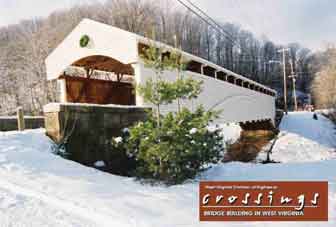 West Virginia’s intent to capitalize on what it had learned by putting to further use the skills perfected during Philippi restoration efforts was evidenced in mid-1990 when
West Virginia’s intent to capitalize on what it had learned by putting to further use the skills perfected during Philippi restoration efforts was evidenced in mid-1990 when the governor announced an ambitious program, estimated at $3.5 million, to restore the state’s remaining covered bridges. At a November 1990 public meeting in Barrackville,
Dr. Emory Kemp, WVU presented preliminary plans for restoring the turn-of-the-century look of the remaining structures, beginning with the Marion County span built by
Lemuel and Eli Chenoweth in 1853 as part of the Fairmont-Wheeling Turnpike.
Barrackville Covered Bridge
In 1991 an Acrow panel-type bridge had to be installed inside the 20-foot-wide, 146-foot-long multiple-kingpost Burr arch truss because of its deteriorating condition, and a $1.3 million upstream replacement began carrying Marion County 21 traffic over Buffalo Creek in 1992. Finally, in late 1997, Governor Cecil Underwood announced that design of a project for the bridge, which had suffered many delays, was back on track, with restoration to “get started before there is any more deterioration of this historic structure.”
At the beginning of 1998, Orders Construction Company, Inc. of St. Albans was awarded a nearly $1.5 million contract to restore the Barrackville Covered Bridge by replacing rotted truss members with wood to match the original, installing a new wooden floor system and repairing the roof, all work aimed at returning the structure to its appearance in the original time period of its construction. Restoration also included siding, which had been added after the structure’s original time period, but did not include a previous sidewalk, since the bridge now serves pedestrians only. An autumn 1999 ribbon-cutting ceremony officially reopened the restored structure.